A Study on the Effect of Training on Employee Performance Report
VerifiedAdded on 2021/04/17
|17
|5619
|388
Report
AI Summary
This report examines the significant impact of training and development on employee performance, highlighting its role in organizational success. It employs a qualitative research approach, reviewing literature and case studies to establish the correlation between training and enhanced employee capabilities. The report delves into theoretical frameworks, analyzes the importance of training, and explores its relationship with employee performance, offering guidelines for employee evaluation and development. It addresses the research problem of understanding how employee performance is affected by training, providing insights into effective training programs, and offering practical suggestions for management. The study acknowledges limitations due to the direct correlation between training and employee performance, suggesting the need for future empirical research. The report's introduction emphasizes the role of training in improving skills, knowledge, and employee motivation, crucial for competitive advantage. It discusses how well-designed training programs optimize employee potential, increase commitment, and contribute to achieving organizational goals. The report covers aspects such as the research problem, objectives, literature review, theoretical frameworks, and research methodology used to assess the effect of training programs on employee performance and offers recommendations for future research and application. It also includes a checklist for assessing employee performance and identifying performance issues, thereby providing valuable guidelines for businesses seeking to improve their workforce through effective training.
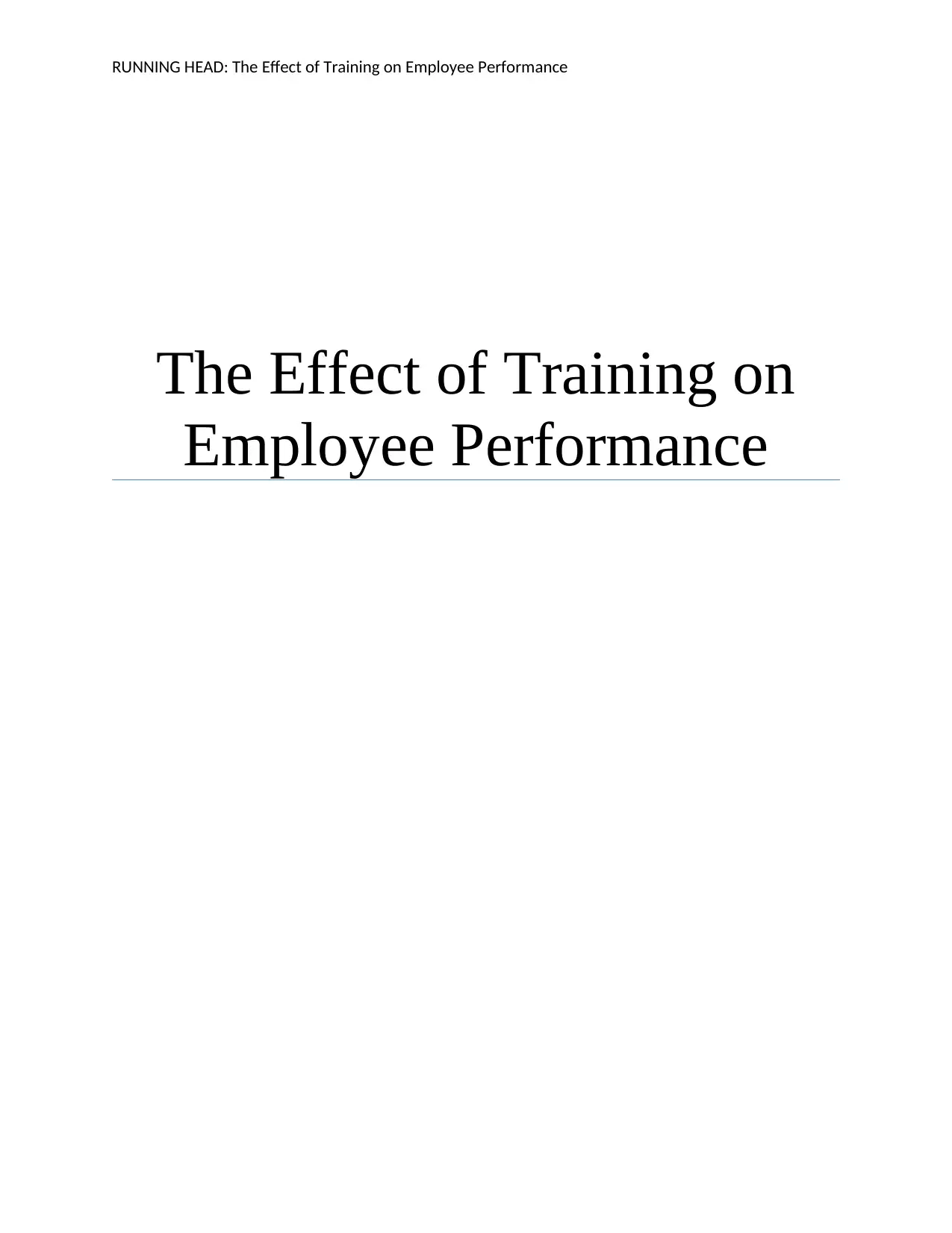
RUNNING HEAD: The Effect of Training on Employee Performance
The Effect of Training on
Employee Performance
The Effect of Training on
Employee Performance
Paraphrase This Document
Need a fresh take? Get an instant paraphrase of this document with our AI Paraphraser
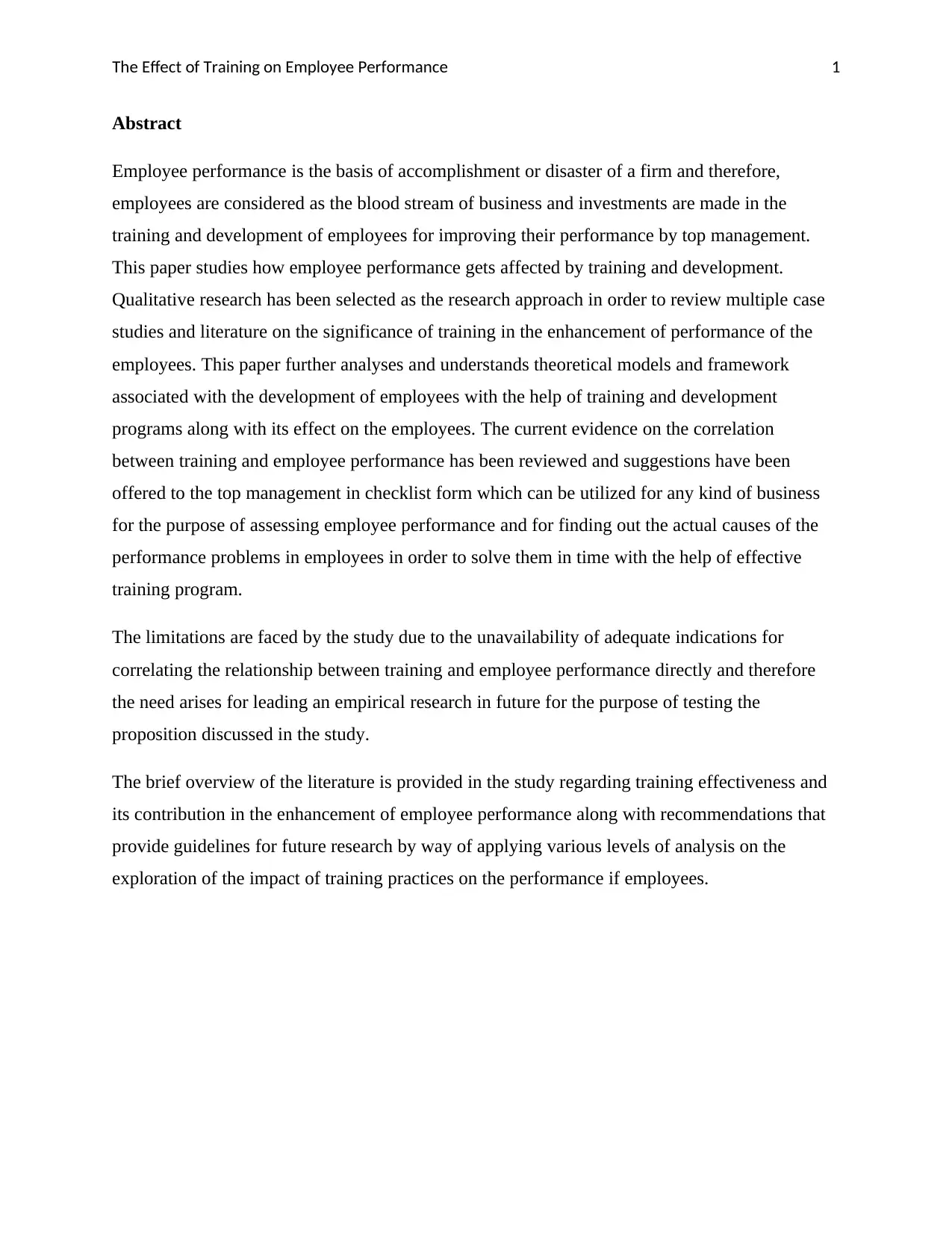
The Effect of Training on Employee Performance 1
Abstract
Employee performance is the basis of accomplishment or disaster of a firm and therefore,
employees are considered as the blood stream of business and investments are made in the
training and development of employees for improving their performance by top management.
This paper studies how employee performance gets affected by training and development.
Qualitative research has been selected as the research approach in order to review multiple case
studies and literature on the significance of training in the enhancement of performance of the
employees. This paper further analyses and understands theoretical models and framework
associated with the development of employees with the help of training and development
programs along with its effect on the employees. The current evidence on the correlation
between training and employee performance has been reviewed and suggestions have been
offered to the top management in checklist form which can be utilized for any kind of business
for the purpose of assessing employee performance and for finding out the actual causes of the
performance problems in employees in order to solve them in time with the help of effective
training program.
The limitations are faced by the study due to the unavailability of adequate indications for
correlating the relationship between training and employee performance directly and therefore
the need arises for leading an empirical research in future for the purpose of testing the
proposition discussed in the study.
The brief overview of the literature is provided in the study regarding training effectiveness and
its contribution in the enhancement of employee performance along with recommendations that
provide guidelines for future research by way of applying various levels of analysis on the
exploration of the impact of training practices on the performance if employees.
Abstract
Employee performance is the basis of accomplishment or disaster of a firm and therefore,
employees are considered as the blood stream of business and investments are made in the
training and development of employees for improving their performance by top management.
This paper studies how employee performance gets affected by training and development.
Qualitative research has been selected as the research approach in order to review multiple case
studies and literature on the significance of training in the enhancement of performance of the
employees. This paper further analyses and understands theoretical models and framework
associated with the development of employees with the help of training and development
programs along with its effect on the employees. The current evidence on the correlation
between training and employee performance has been reviewed and suggestions have been
offered to the top management in checklist form which can be utilized for any kind of business
for the purpose of assessing employee performance and for finding out the actual causes of the
performance problems in employees in order to solve them in time with the help of effective
training program.
The limitations are faced by the study due to the unavailability of adequate indications for
correlating the relationship between training and employee performance directly and therefore
the need arises for leading an empirical research in future for the purpose of testing the
proposition discussed in the study.
The brief overview of the literature is provided in the study regarding training effectiveness and
its contribution in the enhancement of employee performance along with recommendations that
provide guidelines for future research by way of applying various levels of analysis on the
exploration of the impact of training practices on the performance if employees.
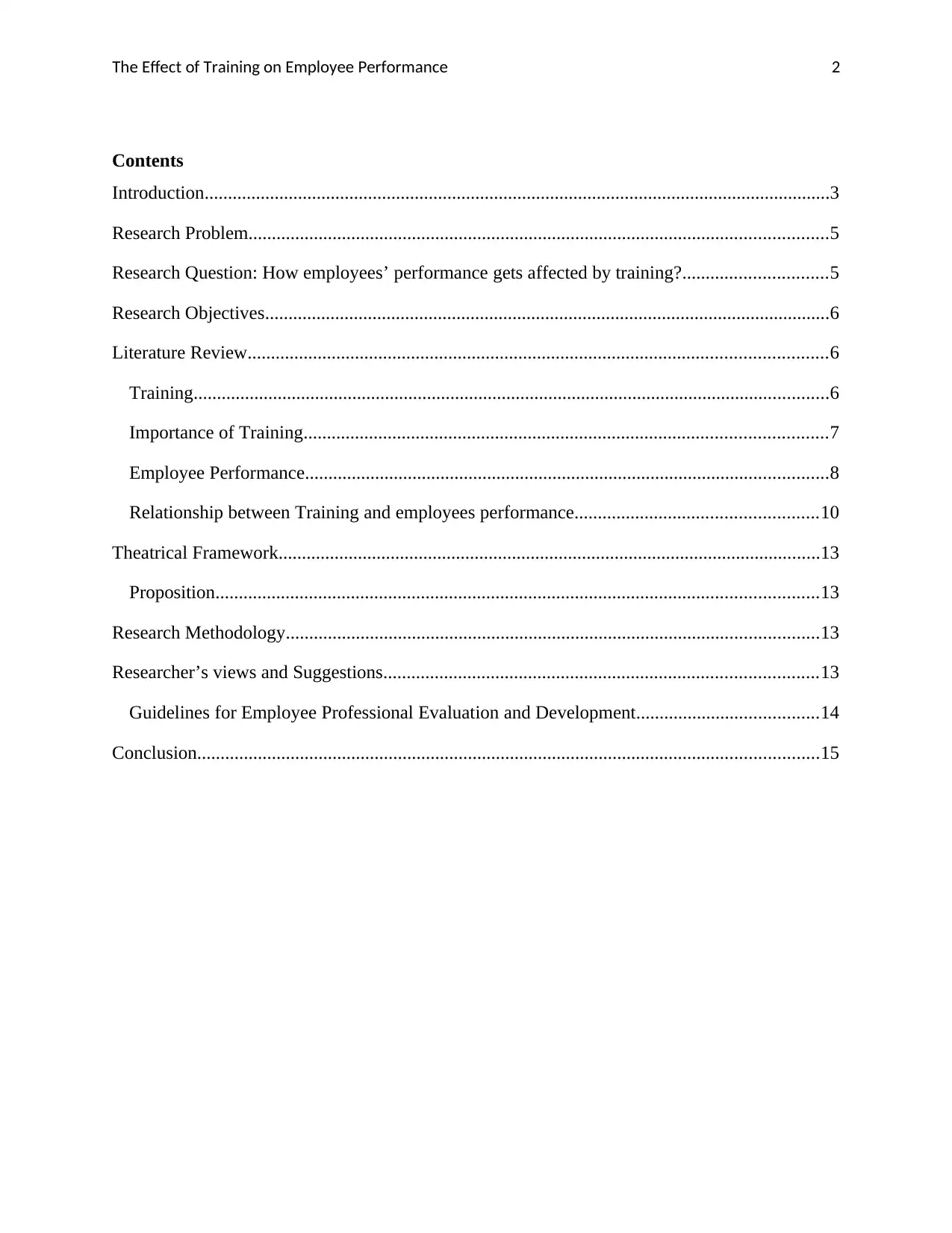
The Effect of Training on Employee Performance 2
Contents
Introduction......................................................................................................................................3
Research Problem............................................................................................................................5
Research Question: How employees’ performance gets affected by training?...............................5
Research Objectives.........................................................................................................................6
Literature Review............................................................................................................................6
Training........................................................................................................................................6
Importance of Training................................................................................................................7
Employee Performance................................................................................................................8
Relationship between Training and employees performance....................................................10
Theatrical Framework....................................................................................................................13
Proposition.................................................................................................................................13
Research Methodology..................................................................................................................13
Researcher’s views and Suggestions.............................................................................................13
Guidelines for Employee Professional Evaluation and Development.......................................14
Conclusion.....................................................................................................................................15
Contents
Introduction......................................................................................................................................3
Research Problem............................................................................................................................5
Research Question: How employees’ performance gets affected by training?...............................5
Research Objectives.........................................................................................................................6
Literature Review............................................................................................................................6
Training........................................................................................................................................6
Importance of Training................................................................................................................7
Employee Performance................................................................................................................8
Relationship between Training and employees performance....................................................10
Theatrical Framework....................................................................................................................13
Proposition.................................................................................................................................13
Research Methodology..................................................................................................................13
Researcher’s views and Suggestions.............................................................................................13
Guidelines for Employee Professional Evaluation and Development.......................................14
Conclusion.....................................................................................................................................15
⊘ This is a preview!⊘
Do you want full access?
Subscribe today to unlock all pages.

Trusted by 1+ million students worldwide
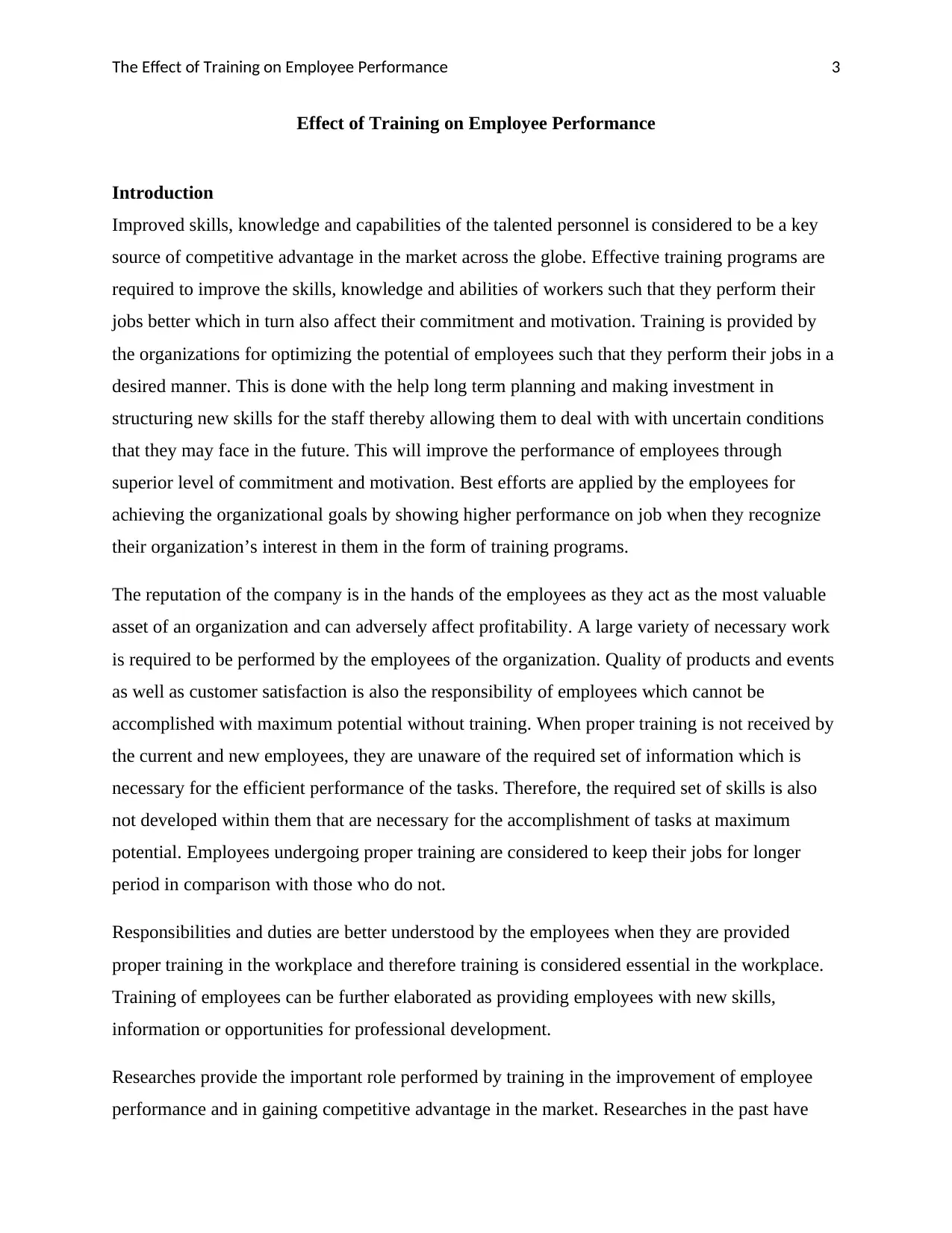
The Effect of Training on Employee Performance 3
Effect of Training on Employee Performance
Introduction
Improved skills, knowledge and capabilities of the talented personnel is considered to be a key
source of competitive advantage in the market across the globe. Effective training programs are
required to improve the skills, knowledge and abilities of workers such that they perform their
jobs better which in turn also affect their commitment and motivation. Training is provided by
the organizations for optimizing the potential of employees such that they perform their jobs in a
desired manner. This is done with the help long term planning and making investment in
structuring new skills for the staff thereby allowing them to deal with with uncertain conditions
that they may face in the future. This will improve the performance of employees through
superior level of commitment and motivation. Best efforts are applied by the employees for
achieving the organizational goals by showing higher performance on job when they recognize
their organization’s interest in them in the form of training programs.
The reputation of the company is in the hands of the employees as they act as the most valuable
asset of an organization and can adversely affect profitability. A large variety of necessary work
is required to be performed by the employees of the organization. Quality of products and events
as well as customer satisfaction is also the responsibility of employees which cannot be
accomplished with maximum potential without training. When proper training is not received by
the current and new employees, they are unaware of the required set of information which is
necessary for the efficient performance of the tasks. Therefore, the required set of skills is also
not developed within them that are necessary for the accomplishment of tasks at maximum
potential. Employees undergoing proper training are considered to keep their jobs for longer
period in comparison with those who do not.
Responsibilities and duties are better understood by the employees when they are provided
proper training in the workplace and therefore training is considered essential in the workplace.
Training of employees can be further elaborated as providing employees with new skills,
information or opportunities for professional development.
Researches provide the important role performed by training in the improvement of employee
performance and in gaining competitive advantage in the market. Researches in the past have
Effect of Training on Employee Performance
Introduction
Improved skills, knowledge and capabilities of the talented personnel is considered to be a key
source of competitive advantage in the market across the globe. Effective training programs are
required to improve the skills, knowledge and abilities of workers such that they perform their
jobs better which in turn also affect their commitment and motivation. Training is provided by
the organizations for optimizing the potential of employees such that they perform their jobs in a
desired manner. This is done with the help long term planning and making investment in
structuring new skills for the staff thereby allowing them to deal with with uncertain conditions
that they may face in the future. This will improve the performance of employees through
superior level of commitment and motivation. Best efforts are applied by the employees for
achieving the organizational goals by showing higher performance on job when they recognize
their organization’s interest in them in the form of training programs.
The reputation of the company is in the hands of the employees as they act as the most valuable
asset of an organization and can adversely affect profitability. A large variety of necessary work
is required to be performed by the employees of the organization. Quality of products and events
as well as customer satisfaction is also the responsibility of employees which cannot be
accomplished with maximum potential without training. When proper training is not received by
the current and new employees, they are unaware of the required set of information which is
necessary for the efficient performance of the tasks. Therefore, the required set of skills is also
not developed within them that are necessary for the accomplishment of tasks at maximum
potential. Employees undergoing proper training are considered to keep their jobs for longer
period in comparison with those who do not.
Responsibilities and duties are better understood by the employees when they are provided
proper training in the workplace and therefore training is considered essential in the workplace.
Training of employees can be further elaborated as providing employees with new skills,
information or opportunities for professional development.
Researches provide the important role performed by training in the improvement of employee
performance and in gaining competitive advantage in the market. Researches in the past have
Paraphrase This Document
Need a fresh take? Get an instant paraphrase of this document with our AI Paraphraser
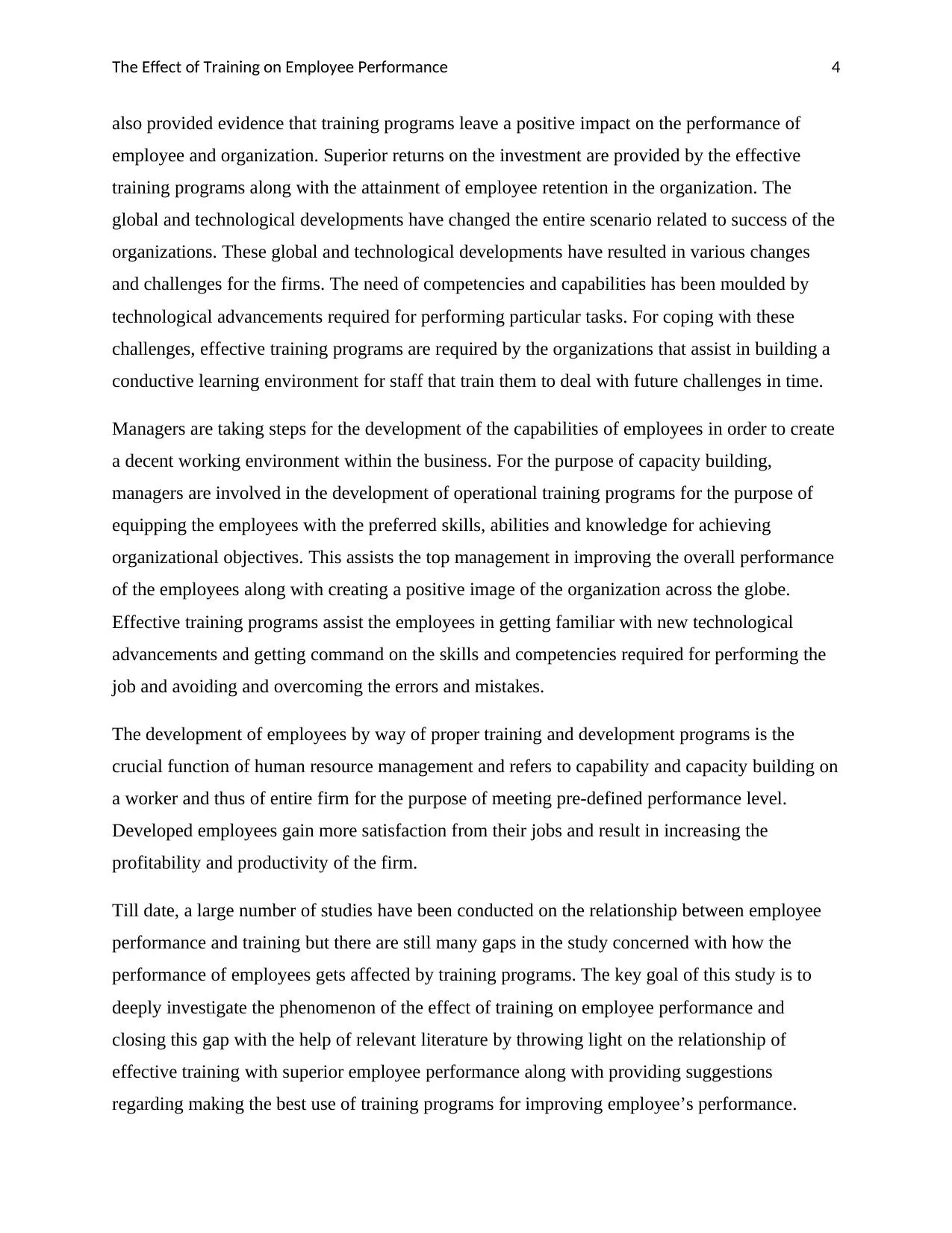
The Effect of Training on Employee Performance 4
also provided evidence that training programs leave a positive impact on the performance of
employee and organization. Superior returns on the investment are provided by the effective
training programs along with the attainment of employee retention in the organization. The
global and technological developments have changed the entire scenario related to success of the
organizations. These global and technological developments have resulted in various changes
and challenges for the firms. The need of competencies and capabilities has been moulded by
technological advancements required for performing particular tasks. For coping with these
challenges, effective training programs are required by the organizations that assist in building a
conductive learning environment for staff that train them to deal with future challenges in time.
Managers are taking steps for the development of the capabilities of employees in order to create
a decent working environment within the business. For the purpose of capacity building,
managers are involved in the development of operational training programs for the purpose of
equipping the employees with the preferred skills, abilities and knowledge for achieving
organizational objectives. This assists the top management in improving the overall performance
of the employees along with creating a positive image of the organization across the globe.
Effective training programs assist the employees in getting familiar with new technological
advancements and getting command on the skills and competencies required for performing the
job and avoiding and overcoming the errors and mistakes.
The development of employees by way of proper training and development programs is the
crucial function of human resource management and refers to capability and capacity building on
a worker and thus of entire firm for the purpose of meeting pre-defined performance level.
Developed employees gain more satisfaction from their jobs and result in increasing the
profitability and productivity of the firm.
Till date, a large number of studies have been conducted on the relationship between employee
performance and training but there are still many gaps in the study concerned with how the
performance of employees gets affected by training programs. The key goal of this study is to
deeply investigate the phenomenon of the effect of training on employee performance and
closing this gap with the help of relevant literature by throwing light on the relationship of
effective training with superior employee performance along with providing suggestions
regarding making the best use of training programs for improving employee’s performance.
also provided evidence that training programs leave a positive impact on the performance of
employee and organization. Superior returns on the investment are provided by the effective
training programs along with the attainment of employee retention in the organization. The
global and technological developments have changed the entire scenario related to success of the
organizations. These global and technological developments have resulted in various changes
and challenges for the firms. The need of competencies and capabilities has been moulded by
technological advancements required for performing particular tasks. For coping with these
challenges, effective training programs are required by the organizations that assist in building a
conductive learning environment for staff that train them to deal with future challenges in time.
Managers are taking steps for the development of the capabilities of employees in order to create
a decent working environment within the business. For the purpose of capacity building,
managers are involved in the development of operational training programs for the purpose of
equipping the employees with the preferred skills, abilities and knowledge for achieving
organizational objectives. This assists the top management in improving the overall performance
of the employees along with creating a positive image of the organization across the globe.
Effective training programs assist the employees in getting familiar with new technological
advancements and getting command on the skills and competencies required for performing the
job and avoiding and overcoming the errors and mistakes.
The development of employees by way of proper training and development programs is the
crucial function of human resource management and refers to capability and capacity building on
a worker and thus of entire firm for the purpose of meeting pre-defined performance level.
Developed employees gain more satisfaction from their jobs and result in increasing the
profitability and productivity of the firm.
Till date, a large number of studies have been conducted on the relationship between employee
performance and training but there are still many gaps in the study concerned with how the
performance of employees gets affected by training programs. The key goal of this study is to
deeply investigate the phenomenon of the effect of training on employee performance and
closing this gap with the help of relevant literature by throwing light on the relationship of
effective training with superior employee performance along with providing suggestions
regarding making the best use of training programs for improving employee’s performance.
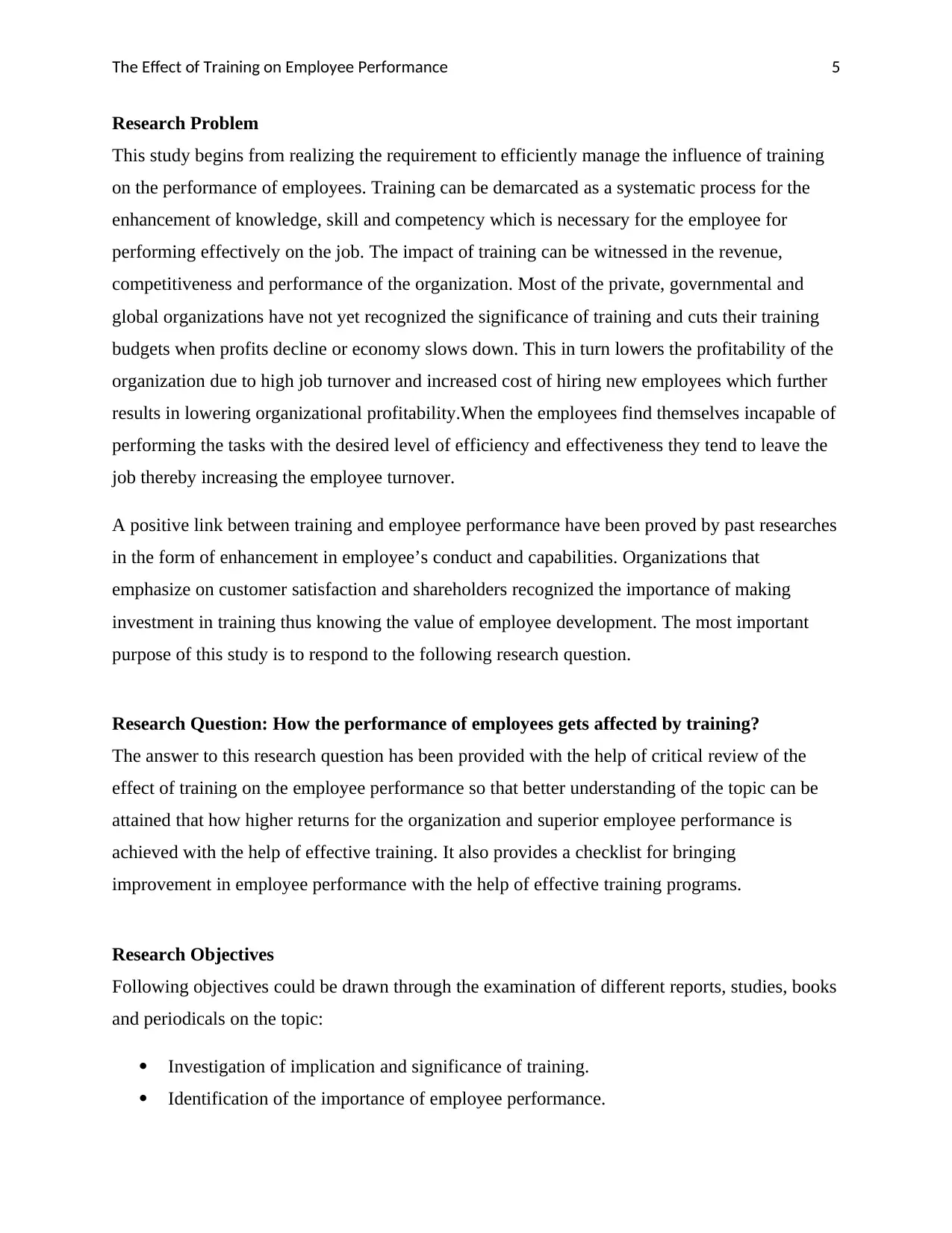
The Effect of Training on Employee Performance 5
Research Problem
This study begins from realizing the requirement to efficiently manage the influence of training
on the performance of employees. Training can be demarcated as a systematic process for the
enhancement of knowledge, skill and competency which is necessary for the employee for
performing effectively on the job. The impact of training can be witnessed in the revenue,
competitiveness and performance of the organization. Most of the private, governmental and
global organizations have not yet recognized the significance of training and cuts their training
budgets when profits decline or economy slows down. This in turn lowers the profitability of the
organization due to high job turnover and increased cost of hiring new employees which further
results in lowering organizational profitability.When the employees find themselves incapable of
performing the tasks with the desired level of efficiency and effectiveness they tend to leave the
job thereby increasing the employee turnover.
A positive link between training and employee performance have been proved by past researches
in the form of enhancement in employee’s conduct and capabilities. Organizations that
emphasize on customer satisfaction and shareholders recognized the importance of making
investment in training thus knowing the value of employee development. The most important
purpose of this study is to respond to the following research question.
Research Question: How the performance of employees gets affected by training?
The answer to this research question has been provided with the help of critical review of the
effect of training on the employee performance so that better understanding of the topic can be
attained that how higher returns for the organization and superior employee performance is
achieved with the help of effective training. It also provides a checklist for bringing
improvement in employee performance with the help of effective training programs.
Research Objectives
Following objectives could be drawn through the examination of different reports, studies, books
and periodicals on the topic:
Investigation of implication and significance of training.
Identification of the importance of employee performance.
Research Problem
This study begins from realizing the requirement to efficiently manage the influence of training
on the performance of employees. Training can be demarcated as a systematic process for the
enhancement of knowledge, skill and competency which is necessary for the employee for
performing effectively on the job. The impact of training can be witnessed in the revenue,
competitiveness and performance of the organization. Most of the private, governmental and
global organizations have not yet recognized the significance of training and cuts their training
budgets when profits decline or economy slows down. This in turn lowers the profitability of the
organization due to high job turnover and increased cost of hiring new employees which further
results in lowering organizational profitability.When the employees find themselves incapable of
performing the tasks with the desired level of efficiency and effectiveness they tend to leave the
job thereby increasing the employee turnover.
A positive link between training and employee performance have been proved by past researches
in the form of enhancement in employee’s conduct and capabilities. Organizations that
emphasize on customer satisfaction and shareholders recognized the importance of making
investment in training thus knowing the value of employee development. The most important
purpose of this study is to respond to the following research question.
Research Question: How the performance of employees gets affected by training?
The answer to this research question has been provided with the help of critical review of the
effect of training on the employee performance so that better understanding of the topic can be
attained that how higher returns for the organization and superior employee performance is
achieved with the help of effective training. It also provides a checklist for bringing
improvement in employee performance with the help of effective training programs.
Research Objectives
Following objectives could be drawn through the examination of different reports, studies, books
and periodicals on the topic:
Investigation of implication and significance of training.
Identification of the importance of employee performance.
⊘ This is a preview!⊘
Do you want full access?
Subscribe today to unlock all pages.

Trusted by 1+ million students worldwide
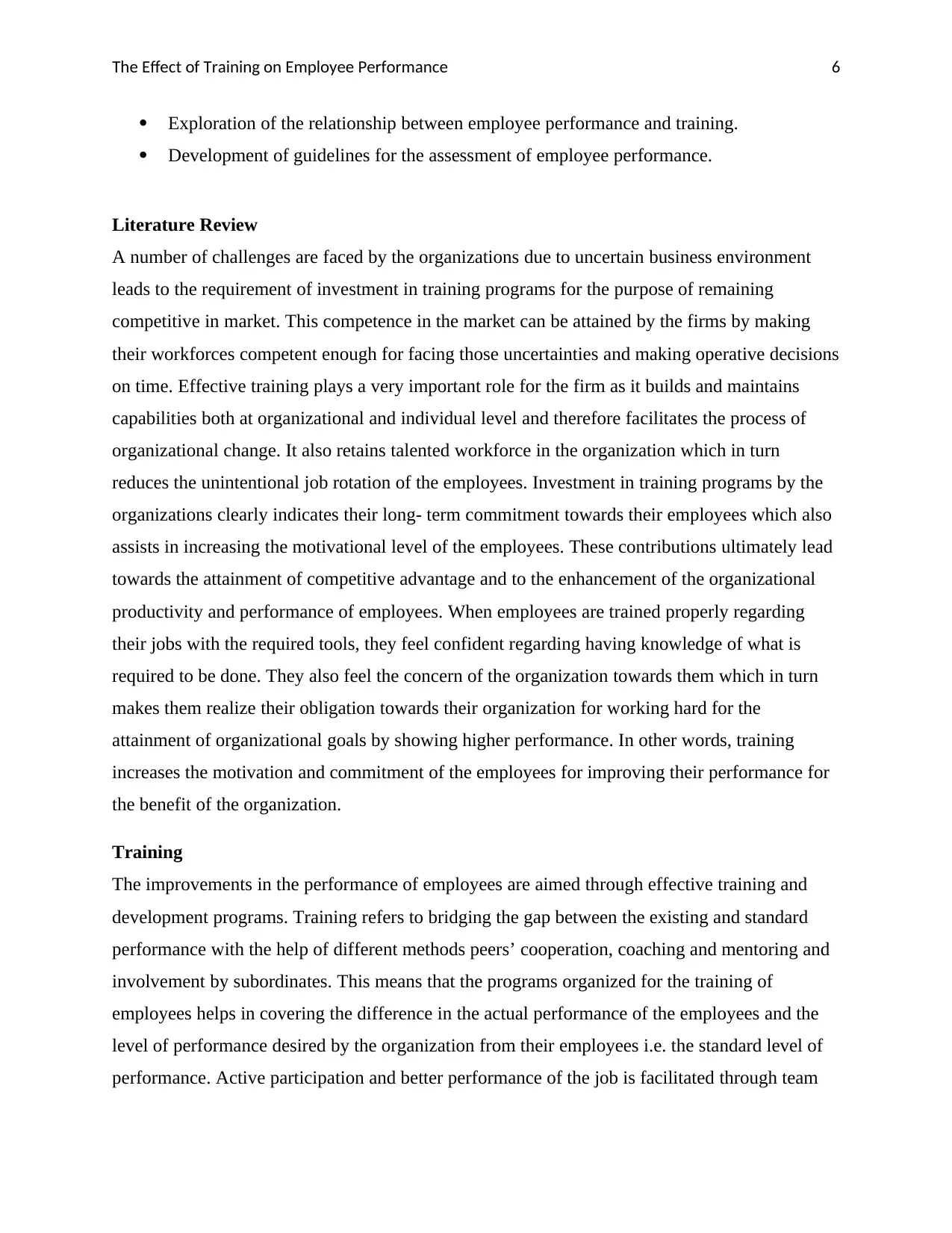
The Effect of Training on Employee Performance 6
Exploration of the relationship between employee performance and training.
Development of guidelines for the assessment of employee performance.
Literature Review
A number of challenges are faced by the organizations due to uncertain business environment
leads to the requirement of investment in training programs for the purpose of remaining
competitive in market. This competence in the market can be attained by the firms by making
their workforces competent enough for facing those uncertainties and making operative decisions
on time. Effective training plays a very important role for the firm as it builds and maintains
capabilities both at organizational and individual level and therefore facilitates the process of
organizational change. It also retains talented workforce in the organization which in turn
reduces the unintentional job rotation of the employees. Investment in training programs by the
organizations clearly indicates their long- term commitment towards their employees which also
assists in increasing the motivational level of the employees. These contributions ultimately lead
towards the attainment of competitive advantage and to the enhancement of the organizational
productivity and performance of employees. When employees are trained properly regarding
their jobs with the required tools, they feel confident regarding having knowledge of what is
required to be done. They also feel the concern of the organization towards them which in turn
makes them realize their obligation towards their organization for working hard for the
attainment of organizational goals by showing higher performance. In other words, training
increases the motivation and commitment of the employees for improving their performance for
the benefit of the organization.
Training
The improvements in the performance of employees are aimed through effective training and
development programs. Training refers to bridging the gap between the existing and standard
performance with the help of different methods peers’ cooperation, coaching and mentoring and
involvement by subordinates. This means that the programs organized for the training of
employees helps in covering the difference in the actual performance of the employees and the
level of performance desired by the organization from their employees i.e. the standard level of
performance. Active participation and better performance of the job is facilitated through team
Exploration of the relationship between employee performance and training.
Development of guidelines for the assessment of employee performance.
Literature Review
A number of challenges are faced by the organizations due to uncertain business environment
leads to the requirement of investment in training programs for the purpose of remaining
competitive in market. This competence in the market can be attained by the firms by making
their workforces competent enough for facing those uncertainties and making operative decisions
on time. Effective training plays a very important role for the firm as it builds and maintains
capabilities both at organizational and individual level and therefore facilitates the process of
organizational change. It also retains talented workforce in the organization which in turn
reduces the unintentional job rotation of the employees. Investment in training programs by the
organizations clearly indicates their long- term commitment towards their employees which also
assists in increasing the motivational level of the employees. These contributions ultimately lead
towards the attainment of competitive advantage and to the enhancement of the organizational
productivity and performance of employees. When employees are trained properly regarding
their jobs with the required tools, they feel confident regarding having knowledge of what is
required to be done. They also feel the concern of the organization towards them which in turn
makes them realize their obligation towards their organization for working hard for the
attainment of organizational goals by showing higher performance. In other words, training
increases the motivation and commitment of the employees for improving their performance for
the benefit of the organization.
Training
The improvements in the performance of employees are aimed through effective training and
development programs. Training refers to bridging the gap between the existing and standard
performance with the help of different methods peers’ cooperation, coaching and mentoring and
involvement by subordinates. This means that the programs organized for the training of
employees helps in covering the difference in the actual performance of the employees and the
level of performance desired by the organization from their employees i.e. the standard level of
performance. Active participation and better performance of the job is facilitated through team
Paraphrase This Document
Need a fresh take? Get an instant paraphrase of this document with our AI Paraphraser
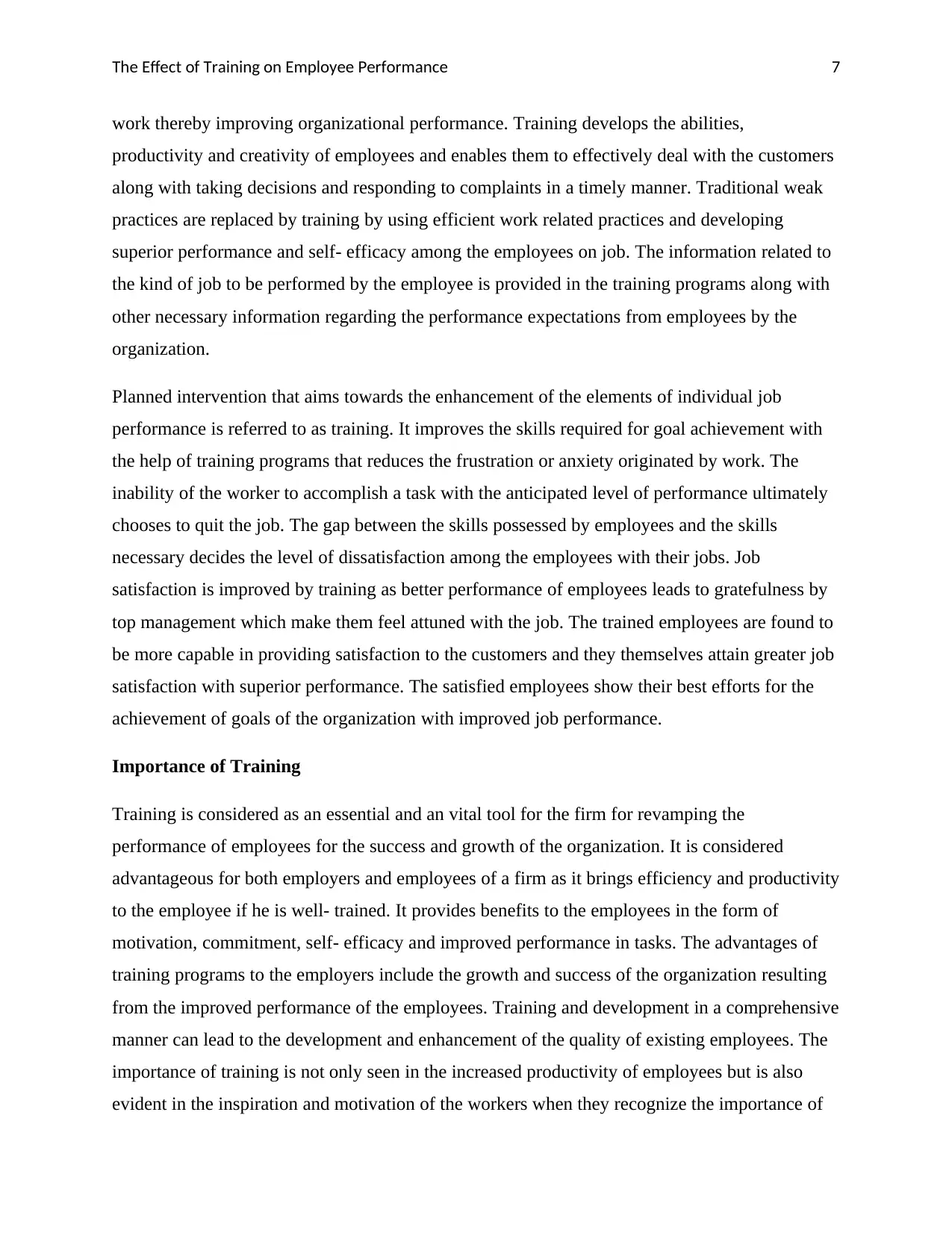
The Effect of Training on Employee Performance 7
work thereby improving organizational performance. Training develops the abilities,
productivity and creativity of employees and enables them to effectively deal with the customers
along with taking decisions and responding to complaints in a timely manner. Traditional weak
practices are replaced by training by using efficient work related practices and developing
superior performance and self- efficacy among the employees on job. The information related to
the kind of job to be performed by the employee is provided in the training programs along with
other necessary information regarding the performance expectations from employees by the
organization.
Planned intervention that aims towards the enhancement of the elements of individual job
performance is referred to as training. It improves the skills required for goal achievement with
the help of training programs that reduces the frustration or anxiety originated by work. The
inability of the worker to accomplish a task with the anticipated level of performance ultimately
chooses to quit the job. The gap between the skills possessed by employees and the skills
necessary decides the level of dissatisfaction among the employees with their jobs. Job
satisfaction is improved by training as better performance of employees leads to gratefulness by
top management which make them feel attuned with the job. The trained employees are found to
be more capable in providing satisfaction to the customers and they themselves attain greater job
satisfaction with superior performance. The satisfied employees show their best efforts for the
achievement of goals of the organization with improved job performance.
Importance of Training
Training is considered as an essential and an vital tool for the firm for revamping the
performance of employees for the success and growth of the organization. It is considered
advantageous for both employers and employees of a firm as it brings efficiency and productivity
to the employee if he is well- trained. It provides benefits to the employees in the form of
motivation, commitment, self- efficacy and improved performance in tasks. The advantages of
training programs to the employers include the growth and success of the organization resulting
from the improved performance of the employees. Training and development in a comprehensive
manner can lead to the development and enhancement of the quality of existing employees. The
importance of training is not only seen in the increased productivity of employees but is also
evident in the inspiration and motivation of the workers when they recognize the importance of
work thereby improving organizational performance. Training develops the abilities,
productivity and creativity of employees and enables them to effectively deal with the customers
along with taking decisions and responding to complaints in a timely manner. Traditional weak
practices are replaced by training by using efficient work related practices and developing
superior performance and self- efficacy among the employees on job. The information related to
the kind of job to be performed by the employee is provided in the training programs along with
other necessary information regarding the performance expectations from employees by the
organization.
Planned intervention that aims towards the enhancement of the elements of individual job
performance is referred to as training. It improves the skills required for goal achievement with
the help of training programs that reduces the frustration or anxiety originated by work. The
inability of the worker to accomplish a task with the anticipated level of performance ultimately
chooses to quit the job. The gap between the skills possessed by employees and the skills
necessary decides the level of dissatisfaction among the employees with their jobs. Job
satisfaction is improved by training as better performance of employees leads to gratefulness by
top management which make them feel attuned with the job. The trained employees are found to
be more capable in providing satisfaction to the customers and they themselves attain greater job
satisfaction with superior performance. The satisfied employees show their best efforts for the
achievement of goals of the organization with improved job performance.
Importance of Training
Training is considered as an essential and an vital tool for the firm for revamping the
performance of employees for the success and growth of the organization. It is considered
advantageous for both employers and employees of a firm as it brings efficiency and productivity
to the employee if he is well- trained. It provides benefits to the employees in the form of
motivation, commitment, self- efficacy and improved performance in tasks. The advantages of
training programs to the employers include the growth and success of the organization resulting
from the improved performance of the employees. Training and development in a comprehensive
manner can lead to the development and enhancement of the quality of existing employees. The
importance of training is not only seen in the increased productivity of employees but is also
evident in the inspiration and motivation of the workers when they recognize the importance of
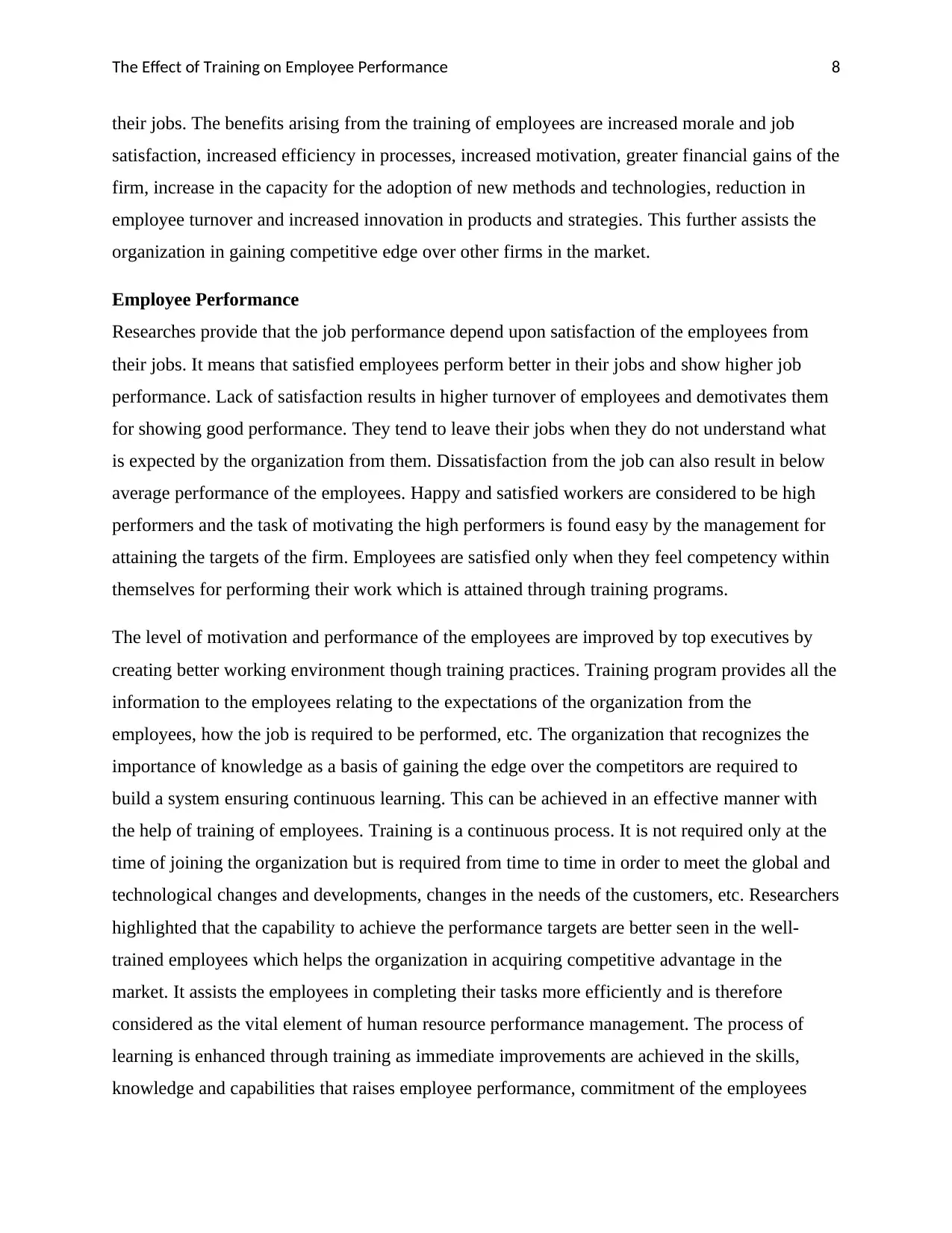
The Effect of Training on Employee Performance 8
their jobs. The benefits arising from the training of employees are increased morale and job
satisfaction, increased efficiency in processes, increased motivation, greater financial gains of the
firm, increase in the capacity for the adoption of new methods and technologies, reduction in
employee turnover and increased innovation in products and strategies. This further assists the
organization in gaining competitive edge over other firms in the market.
Employee Performance
Researches provide that the job performance depend upon satisfaction of the employees from
their jobs. It means that satisfied employees perform better in their jobs and show higher job
performance. Lack of satisfaction results in higher turnover of employees and demotivates them
for showing good performance. They tend to leave their jobs when they do not understand what
is expected by the organization from them. Dissatisfaction from the job can also result in below
average performance of the employees. Happy and satisfied workers are considered to be high
performers and the task of motivating the high performers is found easy by the management for
attaining the targets of the firm. Employees are satisfied only when they feel competency within
themselves for performing their work which is attained through training programs.
The level of motivation and performance of the employees are improved by top executives by
creating better working environment though training practices. Training program provides all the
information to the employees relating to the expectations of the organization from the
employees, how the job is required to be performed, etc. The organization that recognizes the
importance of knowledge as a basis of gaining the edge over the competitors are required to
build a system ensuring continuous learning. This can be achieved in an effective manner with
the help of training of employees. Training is a continuous process. It is not required only at the
time of joining the organization but is required from time to time in order to meet the global and
technological changes and developments, changes in the needs of the customers, etc. Researchers
highlighted that the capability to achieve the performance targets are better seen in the well-
trained employees which helps the organization in acquiring competitive advantage in the
market. It assists the employees in completing their tasks more efficiently and is therefore
considered as the vital element of human resource performance management. The process of
learning is enhanced through training as immediate improvements are achieved in the skills,
knowledge and capabilities that raises employee performance, commitment of the employees
their jobs. The benefits arising from the training of employees are increased morale and job
satisfaction, increased efficiency in processes, increased motivation, greater financial gains of the
firm, increase in the capacity for the adoption of new methods and technologies, reduction in
employee turnover and increased innovation in products and strategies. This further assists the
organization in gaining competitive edge over other firms in the market.
Employee Performance
Researches provide that the job performance depend upon satisfaction of the employees from
their jobs. It means that satisfied employees perform better in their jobs and show higher job
performance. Lack of satisfaction results in higher turnover of employees and demotivates them
for showing good performance. They tend to leave their jobs when they do not understand what
is expected by the organization from them. Dissatisfaction from the job can also result in below
average performance of the employees. Happy and satisfied workers are considered to be high
performers and the task of motivating the high performers is found easy by the management for
attaining the targets of the firm. Employees are satisfied only when they feel competency within
themselves for performing their work which is attained through training programs.
The level of motivation and performance of the employees are improved by top executives by
creating better working environment though training practices. Training program provides all the
information to the employees relating to the expectations of the organization from the
employees, how the job is required to be performed, etc. The organization that recognizes the
importance of knowledge as a basis of gaining the edge over the competitors are required to
build a system ensuring continuous learning. This can be achieved in an effective manner with
the help of training of employees. Training is a continuous process. It is not required only at the
time of joining the organization but is required from time to time in order to meet the global and
technological changes and developments, changes in the needs of the customers, etc. Researchers
highlighted that the capability to achieve the performance targets are better seen in the well-
trained employees which helps the organization in acquiring competitive advantage in the
market. It assists the employees in completing their tasks more efficiently and is therefore
considered as the vital element of human resource performance management. The process of
learning is enhanced through training as immediate improvements are achieved in the skills,
knowledge and capabilities that raises employee performance, commitment of the employees
⊘ This is a preview!⊘
Do you want full access?
Subscribe today to unlock all pages.

Trusted by 1+ million students worldwide
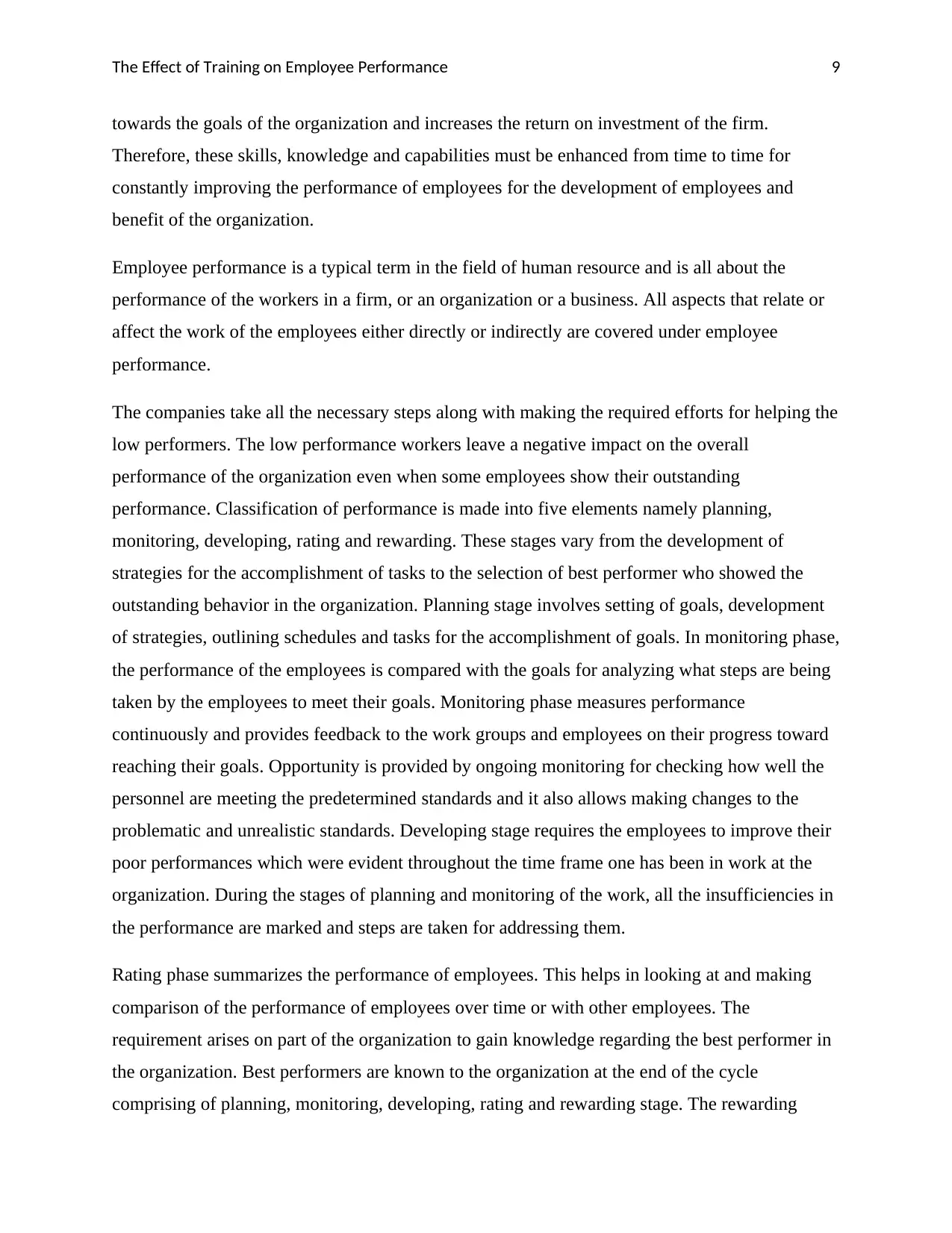
The Effect of Training on Employee Performance 9
towards the goals of the organization and increases the return on investment of the firm.
Therefore, these skills, knowledge and capabilities must be enhanced from time to time for
constantly improving the performance of employees for the development of employees and
benefit of the organization.
Employee performance is a typical term in the field of human resource and is all about the
performance of the workers in a firm, or an organization or a business. All aspects that relate or
affect the work of the employees either directly or indirectly are covered under employee
performance.
The companies take all the necessary steps along with making the required efforts for helping the
low performers. The low performance workers leave a negative impact on the overall
performance of the organization even when some employees show their outstanding
performance. Classification of performance is made into five elements namely planning,
monitoring, developing, rating and rewarding. These stages vary from the development of
strategies for the accomplishment of tasks to the selection of best performer who showed the
outstanding behavior in the organization. Planning stage involves setting of goals, development
of strategies, outlining schedules and tasks for the accomplishment of goals. In monitoring phase,
the performance of the employees is compared with the goals for analyzing what steps are being
taken by the employees to meet their goals. Monitoring phase measures performance
continuously and provides feedback to the work groups and employees on their progress toward
reaching their goals. Opportunity is provided by ongoing monitoring for checking how well the
personnel are meeting the predetermined standards and it also allows making changes to the
problematic and unrealistic standards. Developing stage requires the employees to improve their
poor performances which were evident throughout the time frame one has been in work at the
organization. During the stages of planning and monitoring of the work, all the insufficiencies in
the performance are marked and steps are taken for addressing them.
Rating phase summarizes the performance of employees. This helps in looking at and making
comparison of the performance of employees over time or with other employees. The
requirement arises on part of the organization to gain knowledge regarding the best performer in
the organization. Best performers are known to the organization at the end of the cycle
comprising of planning, monitoring, developing, rating and rewarding stage. The rewarding
towards the goals of the organization and increases the return on investment of the firm.
Therefore, these skills, knowledge and capabilities must be enhanced from time to time for
constantly improving the performance of employees for the development of employees and
benefit of the organization.
Employee performance is a typical term in the field of human resource and is all about the
performance of the workers in a firm, or an organization or a business. All aspects that relate or
affect the work of the employees either directly or indirectly are covered under employee
performance.
The companies take all the necessary steps along with making the required efforts for helping the
low performers. The low performance workers leave a negative impact on the overall
performance of the organization even when some employees show their outstanding
performance. Classification of performance is made into five elements namely planning,
monitoring, developing, rating and rewarding. These stages vary from the development of
strategies for the accomplishment of tasks to the selection of best performer who showed the
outstanding behavior in the organization. Planning stage involves setting of goals, development
of strategies, outlining schedules and tasks for the accomplishment of goals. In monitoring phase,
the performance of the employees is compared with the goals for analyzing what steps are being
taken by the employees to meet their goals. Monitoring phase measures performance
continuously and provides feedback to the work groups and employees on their progress toward
reaching their goals. Opportunity is provided by ongoing monitoring for checking how well the
personnel are meeting the predetermined standards and it also allows making changes to the
problematic and unrealistic standards. Developing stage requires the employees to improve their
poor performances which were evident throughout the time frame one has been in work at the
organization. During the stages of planning and monitoring of the work, all the insufficiencies in
the performance are marked and steps are taken for addressing them.
Rating phase summarizes the performance of employees. This helps in looking at and making
comparison of the performance of employees over time or with other employees. The
requirement arises on part of the organization to gain knowledge regarding the best performer in
the organization. Best performers are known to the organization at the end of the cycle
comprising of planning, monitoring, developing, rating and rewarding stage. The rewarding
Paraphrase This Document
Need a fresh take? Get an instant paraphrase of this document with our AI Paraphraser
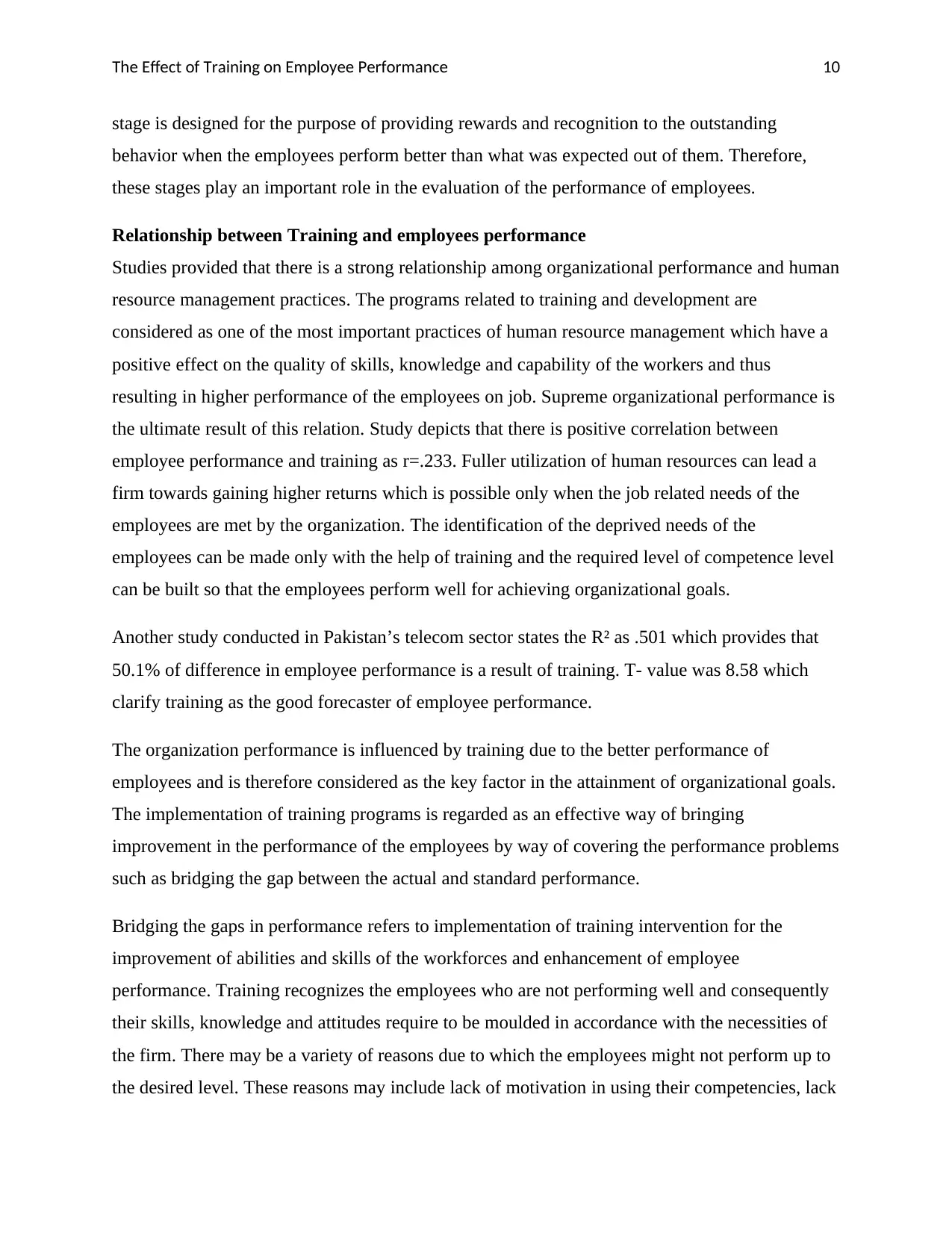
The Effect of Training on Employee Performance 10
stage is designed for the purpose of providing rewards and recognition to the outstanding
behavior when the employees perform better than what was expected out of them. Therefore,
these stages play an important role in the evaluation of the performance of employees.
Relationship between Training and employees performance
Studies provided that there is a strong relationship among organizational performance and human
resource management practices. The programs related to training and development are
considered as one of the most important practices of human resource management which have a
positive effect on the quality of skills, knowledge and capability of the workers and thus
resulting in higher performance of the employees on job. Supreme organizational performance is
the ultimate result of this relation. Study depicts that there is positive correlation between
employee performance and training as r=.233. Fuller utilization of human resources can lead a
firm towards gaining higher returns which is possible only when the job related needs of the
employees are met by the organization. The identification of the deprived needs of the
employees can be made only with the help of training and the required level of competence level
can be built so that the employees perform well for achieving organizational goals.
Another study conducted in Pakistan’s telecom sector states the R² as .501 which provides that
50.1% of difference in employee performance is a result of training. T- value was 8.58 which
clarify training as the good forecaster of employee performance.
The organization performance is influenced by training due to the better performance of
employees and is therefore considered as the key factor in the attainment of organizational goals.
The implementation of training programs is regarded as an effective way of bringing
improvement in the performance of the employees by way of covering the performance problems
such as bridging the gap between the actual and standard performance.
Bridging the gaps in performance refers to implementation of training intervention for the
improvement of abilities and skills of the workforces and enhancement of employee
performance. Training recognizes the employees who are not performing well and consequently
their skills, knowledge and attitudes require to be moulded in accordance with the necessities of
the firm. There may be a variety of reasons due to which the employees might not perform up to
the desired level. These reasons may include lack of motivation in using their competencies, lack
stage is designed for the purpose of providing rewards and recognition to the outstanding
behavior when the employees perform better than what was expected out of them. Therefore,
these stages play an important role in the evaluation of the performance of employees.
Relationship between Training and employees performance
Studies provided that there is a strong relationship among organizational performance and human
resource management practices. The programs related to training and development are
considered as one of the most important practices of human resource management which have a
positive effect on the quality of skills, knowledge and capability of the workers and thus
resulting in higher performance of the employees on job. Supreme organizational performance is
the ultimate result of this relation. Study depicts that there is positive correlation between
employee performance and training as r=.233. Fuller utilization of human resources can lead a
firm towards gaining higher returns which is possible only when the job related needs of the
employees are met by the organization. The identification of the deprived needs of the
employees can be made only with the help of training and the required level of competence level
can be built so that the employees perform well for achieving organizational goals.
Another study conducted in Pakistan’s telecom sector states the R² as .501 which provides that
50.1% of difference in employee performance is a result of training. T- value was 8.58 which
clarify training as the good forecaster of employee performance.
The organization performance is influenced by training due to the better performance of
employees and is therefore considered as the key factor in the attainment of organizational goals.
The implementation of training programs is regarded as an effective way of bringing
improvement in the performance of the employees by way of covering the performance problems
such as bridging the gap between the actual and standard performance.
Bridging the gaps in performance refers to implementation of training intervention for the
improvement of abilities and skills of the workforces and enhancement of employee
performance. Training recognizes the employees who are not performing well and consequently
their skills, knowledge and attitudes require to be moulded in accordance with the necessities of
the firm. There may be a variety of reasons due to which the employees might not perform up to
the desired level. These reasons may include lack of motivation in using their competencies, lack
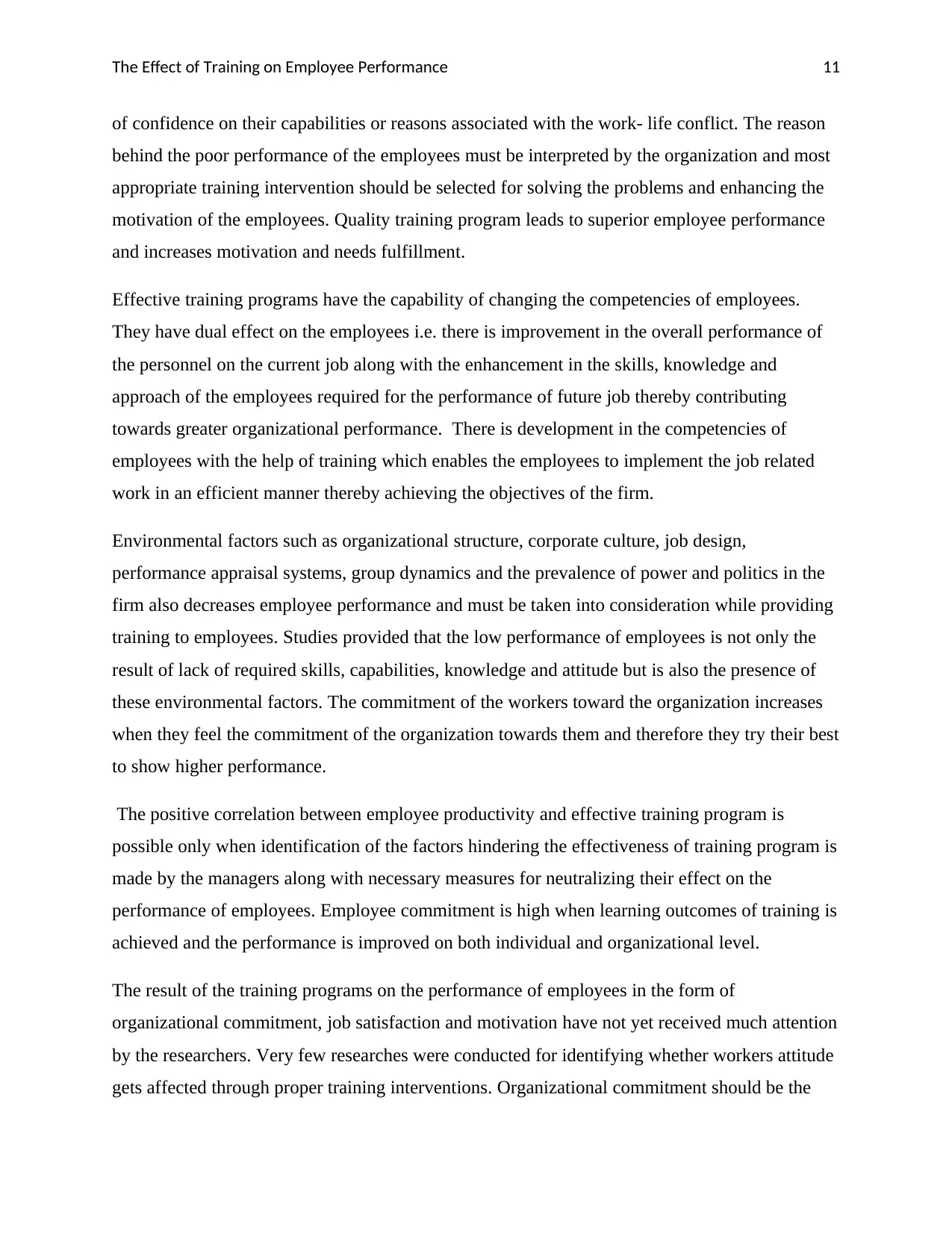
The Effect of Training on Employee Performance 11
of confidence on their capabilities or reasons associated with the work- life conflict. The reason
behind the poor performance of the employees must be interpreted by the organization and most
appropriate training intervention should be selected for solving the problems and enhancing the
motivation of the employees. Quality training program leads to superior employee performance
and increases motivation and needs fulfillment.
Effective training programs have the capability of changing the competencies of employees.
They have dual effect on the employees i.e. there is improvement in the overall performance of
the personnel on the current job along with the enhancement in the skills, knowledge and
approach of the employees required for the performance of future job thereby contributing
towards greater organizational performance. There is development in the competencies of
employees with the help of training which enables the employees to implement the job related
work in an efficient manner thereby achieving the objectives of the firm.
Environmental factors such as organizational structure, corporate culture, job design,
performance appraisal systems, group dynamics and the prevalence of power and politics in the
firm also decreases employee performance and must be taken into consideration while providing
training to employees. Studies provided that the low performance of employees is not only the
result of lack of required skills, capabilities, knowledge and attitude but is also the presence of
these environmental factors. The commitment of the workers toward the organization increases
when they feel the commitment of the organization towards them and therefore they try their best
to show higher performance.
The positive correlation between employee productivity and effective training program is
possible only when identification of the factors hindering the effectiveness of training program is
made by the managers along with necessary measures for neutralizing their effect on the
performance of employees. Employee commitment is high when learning outcomes of training is
achieved and the performance is improved on both individual and organizational level.
The result of the training programs on the performance of employees in the form of
organizational commitment, job satisfaction and motivation have not yet received much attention
by the researchers. Very few researches were conducted for identifying whether workers attitude
gets affected through proper training interventions. Organizational commitment should be the
of confidence on their capabilities or reasons associated with the work- life conflict. The reason
behind the poor performance of the employees must be interpreted by the organization and most
appropriate training intervention should be selected for solving the problems and enhancing the
motivation of the employees. Quality training program leads to superior employee performance
and increases motivation and needs fulfillment.
Effective training programs have the capability of changing the competencies of employees.
They have dual effect on the employees i.e. there is improvement in the overall performance of
the personnel on the current job along with the enhancement in the skills, knowledge and
approach of the employees required for the performance of future job thereby contributing
towards greater organizational performance. There is development in the competencies of
employees with the help of training which enables the employees to implement the job related
work in an efficient manner thereby achieving the objectives of the firm.
Environmental factors such as organizational structure, corporate culture, job design,
performance appraisal systems, group dynamics and the prevalence of power and politics in the
firm also decreases employee performance and must be taken into consideration while providing
training to employees. Studies provided that the low performance of employees is not only the
result of lack of required skills, capabilities, knowledge and attitude but is also the presence of
these environmental factors. The commitment of the workers toward the organization increases
when they feel the commitment of the organization towards them and therefore they try their best
to show higher performance.
The positive correlation between employee productivity and effective training program is
possible only when identification of the factors hindering the effectiveness of training program is
made by the managers along with necessary measures for neutralizing their effect on the
performance of employees. Employee commitment is high when learning outcomes of training is
achieved and the performance is improved on both individual and organizational level.
The result of the training programs on the performance of employees in the form of
organizational commitment, job satisfaction and motivation have not yet received much attention
by the researchers. Very few researches were conducted for identifying whether workers attitude
gets affected through proper training interventions. Organizational commitment should be the
⊘ This is a preview!⊘
Do you want full access?
Subscribe today to unlock all pages.

Trusted by 1+ million students worldwide
1 out of 17
Related Documents
Your All-in-One AI-Powered Toolkit for Academic Success.
+13062052269
info@desklib.com
Available 24*7 on WhatsApp / Email
![[object Object]](/_next/static/media/star-bottom.7253800d.svg)
Unlock your academic potential
Copyright © 2020–2025 A2Z Services. All Rights Reserved. Developed and managed by ZUCOL.





